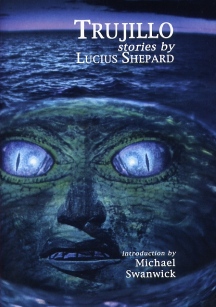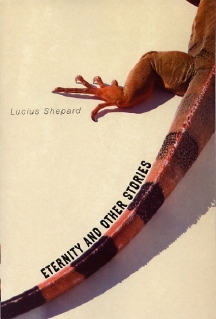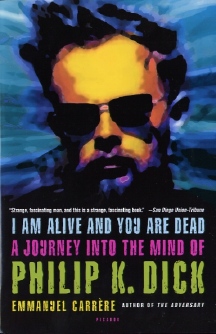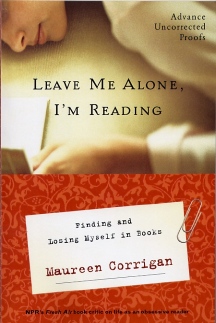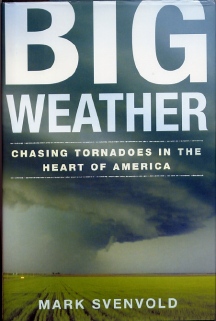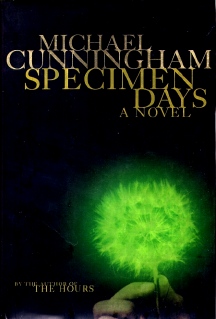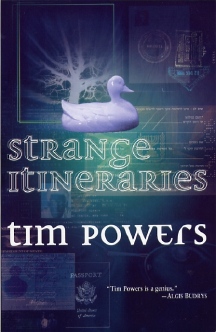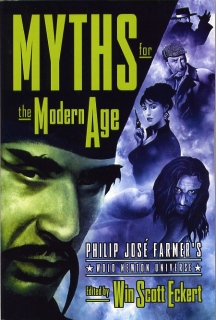|
|
|
This Just In...News from the Agony Column
|
08-25-05: 'Leave Me Alone, I'm Reading' by Maureen Corrigan; 'Big Weather' by Mark Svenvold |
|||
A
Familiar Sentiment
And if you want to know why it seems that I'm always a day a late and dollar short, well there's the reason. You pick up some damned book and before you know it fifty pages and forty minutes have disappeared into your oh-so-tiny brain. Since even the dog was napping, I didn't have to say 'Leave Me Alone, I'm Reading' (Random House ; September 6, 2005 ; $24.95). That's good, because Maureen Corrigan's book is quite a little page-turner for a book about books and reading. It's quite a little page-turner period, because, frankly, I felt like I found a kindred spirit, another human who would just as soon read as do anything else. And if you feel that way, chances are you'll enjoy reading this book as well. " It's not that I don't like people," Corrigan begins. "It's just that when I'm in the company of others–even my nearest and dearest–there always comes a moment when I'd rather be reading a book." Talk about a hook for compulsive readers! OK. You should all know who Maureen Corrigan is. For sixteen years, you've been listening to her book reviews for Fresh Air on NPR. Yes, she reviews the literary literature, but she also reviews mysteries and enjoys serial fiction; she also enjoys using the semicolon. You do something for sixteen years, you know, you get pretty good at it. Maureen Corrigan is a highly experienced reader, and she's got some things to tell even the most pile o' books readers out there about how to read. Now, these are things that every reader of this site already knows. But seeing them expressed with clarity and wit will make you even more enthused and less apologetic about your addiction. This book is the highly caffeinated coffee of your reading diet, something that will get you just slightly-over-excited about the rest of your reading agenda, even if you have little interface with hers. That's the main deal here. Corrigan and I overlap a bit on the literary side and bit on mysteries, but otherwise, poof. And it dont matter a whit, except that it gets me really curious about her choices. As if I need more choices for reading! But who the hell cares, because frankly, it's just a relief to find out that other people have this experience: " 'Do you ever get tired of reading?' people sometime ask me–particularly people who have seen the inside of my house, where stacks of books are piled on the dining room table, the floor of my bedroom and study, and even on the radiators in the summertime." OK, so I dont have radiators here in California, but the rest of it is a spot-on description. What Maureen Corrigan does for the compulsive reading set is to present them to themselves and the world as people every bit as interesting as the books they read and as they think they are. And you dont have to do a thing beyond telling those around you to leave you alone–you're reading. |
|||
Run
This Way – Or This Way
Sorry, wrong number. There's something endlessly fascinating about storms, and so 'Big Weather' (Henry Holt and Co. ; May 10, 2005 ; $26.00) by Mark Svenvold didn't have to sit for very long before it came off the Rolling Shelves and onto the dining room table. What I expected was a book with lots of pictures of well, Big Weather. What you get instead is a book about people who are interested in Big Weather. Big Difference, and better than what you thought you wanted. Tornadoes are not just an American phenomenon, but most of them do happen in the US. And the book is basically about a very peculiar cross section of Americans, pre and post-Twister storm chasers who are looking for excitement, for glory, or for great photographs and film to sell. There's a bizarre cross-up of what Svenvold calls "Catastrophilia" and hucksterism. These guys are sort of like PT Barnum in a crash helmet. But Svenvold genuinely likes his subjects, though he doesn't idolize them. What he does do is give them to you in all their storm chasing, product-hyping glory. Consider it the analysis of a very strange business and the even stranger people who run it. That's the bottom line on 'Big Weather'. It's not really about the weather so much as the folks who follow it. You may like some of these folks, you may not like some of them. You might want to buy their products, and you might buy products from companies who have bought their products. Svenvold knows how to tell a story, and key to great storytelling is great characters. People who follow thunderstorms and tornadoes in specially modified cars might not make great neighbors say, but they surely qualify as great characters. To my mind, any book in which the author coins the term Catastrophilia is a book that I want to read. We live in a culture of Catastrophilia, a rubber-necker's paradise. You can't look away. But you can RUN AWAY. If you're inclined to do the latter but not the former, then perhaps this is the book for you. If not -- run that way. |
|
08-24-05: Michael Cunningham's 'Specimen Days' |
|||
The
Literary Spin
Of course, were he to be a refugee from the genre, we'd probably be condescending and call this novel a fix-up, with its three different narrative threads, set 150 years apart. 'In the Machine', the first section of the novel, takes place in 1850, at the height of the Industrial revolution, and involves a boy who believes that the ghost of his brother inhabits the machine that killed him. 'The Children's Crusade', which follows, is a day-after-tomorrow thriller in which Cat Martin pursues terrorists with an unclear agenda. And finally, 'Like Beauty' is set in a New York overwhelmed by truly alien refugees. Presiding over the entire novel is the Walt Whitman, who gave his autobiography the same title. Cunningham's novel takes its cue from SF in a variety of fashions. We do have a fix-up here, even if it is deliberately conceived as such, and in each portion, he's writing at novella length, again a staple of the science fiction world. If it walks like SF and it talks like SF, I guess that it's SF. We'll pick it up read it and evaluate it on its merits. What is absent from 'Specimen Days' are the kinds of mistakes often made by those who first decide to write in the genre. Cunningham knows that he's using tools, not inventing them, and this makes all the difference in the world. Because he knows that he's not inventing the wheel and discovering fire, he can get on with the business of telling his story in an imaginative fashion, and with his own wonderfully observed prose. His challenge will be to keep his literary audience along for the ride. While science fiction readers are happy to have some literature cut into their genre fiction, literary readers are a bit more skittish when it comes to finding science fiction -- or at least lizard-like aliens -- in their literature. These skeptical readers of literature may have to get used to finding science fiction in their literature. Once a toolbox is opened, it's never closed. The tools get passed around from writer to writer, from generation to generation. With enough use, the toolbox labeled Science Fiction ends up with no label whatsoever, and the tools, be they ghosts in the machine or lizard-like aliens, end up being no more -- and no less -- than elements of style. |
|
08-23-05: Jeffrey Ford's 'The Girl in the Glass'; Tim Powers' 'Strange Itineraries' |
|||
Now
Marketed as TPB Mainstream Literature
The story of 'The Girl in the Glass' is told by a Mexican immigrant who is posing as a Hindu for a scam artist running the old "show us your spirits" act. Look, if you think this thing goes out of style, EVER, then look at the recent success of John Edwards. In Ford's novel, Diego has been taken on by Thomas Schell to add a bit of spice and also to help the poor kid avoid "repatriation". Ford gave a great talk about this in the interview I did with him. In it, he told me about the tendency to blame the poorest for the economic tragedies that the rich often bring on themselves. Thus, even though it was stock speculation that helped bring about the Great Depression, the blame was placed in part on Mexican immigrants who were kindly and conveniently "repatriated." Read "deported, if they are lucky". Diego and Schell bang along scamming New York's grieving rich with faked séances and cheesecloth ectoplasm. That is, until Schell sees an image of a young girl in a pane of glass, asking him for help. That's when he decides to pursue the mystery, to find out who she is -- if she's real -- what she wants and why. Of course, none of this is straightforward, and all of it rapidly becomes very dangerous. Ford is one of those authors that I think really deserves a bestseller; he seems to pack in all sorts of appeal for a wide audience. I'm glad to see him coming back to the historical novel, and I think I'm glad that this is packaged as it is. Now, I'll have to admit that the packaging for 'The Portrait of Mrs. Charbuque was not bad, but it did seem a bit off -- a certainly did not do the novel justice. This is better, but I dont know if theyre going to snag the audience they want here. Presumably, readers who liked Ford last time around will find this one. We know enough to look for him. But readers who dont know about him may not suss from this cover the fact that this is not a navel-gazing novel of angst but a wild and wooly historical mystery laced with a soupcon of the supernatural. Frankly, Ford offers enough prickly texture that he does not need to include the supernatural to make his novels appealing. This is a must buy for me and should be for almost every reader of this site. One aspect of this novel that really interests me is the Dark Alley Imprint. When last we saw them, they were busily publishing another under-known favorite, David J. Schow, with his title 'Bullets of Rain'. Will Dark Alley become a catch-all for some of today's top unclassifiable writers? Stay tuned, I'm looking into this! Dont leave the purchase of this novel to guesswork. The new Jeff Ford novel is out, at long last. Time to celebrate. |
|||
Plan
Your Trip Wisely
Well, needless to say it's not anything in this book. 'Strange Itineraries' is comprised of all the short fiction of Tim Powers, and as such, includes everything in the Subterranean Press volume, 'Night Moves'. It also includes three stories not in that beautifully bound tome; 'Pat Moore' from 'Flights: Extreme Visions of Fantasy', 'Fifty Cents', by James P. Blaylock and Powers, which first appeared in 'The Devils in the Details' from Subterranean Press; and 'Through and Through', which also appeared in 'The Devils in the Details' but is by Powers alone. It's quite nice really, to see the Powers stories collected at such a bargain price. Powers is one of those writers who commands a very hard-core audience of readers. He's been in the best company for along time, as part of a writing group that included Philip K. Dick and Dean R. Koontz. He meticulously crafts his fiction, researching for years on topics before committing them to paper. He's received some of the finest limited editions you can find, thanks to publishers like Charnal House. If you've never read Powers and prefer short stories, then you must buy this collection immediately. If you have read Powers, and dont have this collection, then you'll want it to ensure that your obsessive book-buying compulsion is sated -- and at a very decent price. Hold this one up as a model of effective economic planning, so when you're springing for the Hill House editions you can say, "See, here, remember that Tim Powers' collection? It was only $15.95!" |
|
08-22-05: Myths for the Modern Age Edited by Win Scott Eckert; Guru Guru Pon-Chan by Satomi Ikezawa |
||||
Philip José Farmer's Wold Newton Universe Wrought Large
So we've got a first paragraph with nearly as many imaginary writers as real writers, and that's only appropriate when the book I'm eventually going to get round to talking about is Win Scott Eckert's 'Myths for the Modern Age: Philip José Farmer's Wold Newton Universe' (Monkeybrain Books ; November 2005 ; $14.95). So. When last we were on-topic, we were talking about Farmer, who first came to fame with the then shockingly naughty 'Flesh' of 1960. By the time he headed to 'Riverworld', I was pretty much done with science fiction, or so I thought. The idea of Riverworld never appealed to me; with its use of real figures like Samuel Clemens, it seemed kind of heavy-handed, even as it brought Farmer his largest audience. Go figure. Farmer was to pursue the opposite path as well. In 'Tarzan Alive' and 'Doc Savage: His Apocalyptic Life', he treated fictional characters as if they were real instead of writing fiction about real-life figures like Clemens. These titles were included in the part of Farmer's career I missed. So I also missed the whole Wold Newton family tree, the idea of which was that in the Wold Newton family tree, one could find just about every superhero and ultra-villain one could imagine from the annals of modern pulpish fiction. Thus, you get Sherlock Holmes, Fu Manchu, Philip Marlowe and James Bond all under one big meta-pulp umbrella. Farmer wrote essays and stories that carried these ideas even further, and 'Myths' collects for the first time all of these essays with a shed-load of additional material that brings even more fictional characters into the fold. Imagine me -- fairly well read in this field and a few others -- encountering this for the first time. Wow, I say, wow. Scott Eckert posted the first site on the Internet dedicated to the Wold Newton family and served as "an expert consultant on crossovers involving characters from pulp fiction and Victorian literature for a lawsuit concerning a major motion picture." Say that three times, really fast. No wait -- think that three times really fast, then see if you can a decent sentence with subjects and verbs all in a row. What strikes me as most fascinating about this title is that on the surface, skimming, you're going to wonder where the real scholarly articles about the Wold Newton Family end and the faux scholarly articles about the Wold Newton Family begin. This is a giant, brain-blurring smear across any notions of literary stability or reality you might have wished to hold. Cue the awesome John Picacio cover. Crank up the creaky violin music. The problem here is not that the works in this title don't make sense. The problem is that it all makes too much sense, it all seems too perfect. What the heck is going on here? Is reality really that fictional? Is fiction really that real? If your head's not spinning fast enough, you might want to pick this book up, just to get a little centrifugal force going. And wonder, just wonder, what else you might have missed. |
||||
Del Rey Does Manga
MANGA! Ok, so let's just suppose you're wondering what the heck manga is, exactly. Yes, I know you're all so cued in that this is redundant, but I'm not. So. Why Manga, and why Del Rey, what 'Guru Guru Pon-Chan' (Del Rey / Ballantine / Random House ; August 1, 2005 ; $10.95 ; "Ages 13+"). OK, according to Wikipedia, manga means "random (or whimsical) pictures". Manga has origins as deep as the 12th century, but manga as we know it refers basically to Japanese comics drawn after World War II. Until recently, one might have been tempted to say that manga is more respected and more popular than comic books in the Western world, but work like Neil Gaiman's 'Sandman' series and a spate of big-bucks movie adaptations of comic book characters has pretty much put paid to that notion. Of course, I live in a rather odd world, no? So what we have here are the US big publishers taking a whack at Manga, and pretty much doing it very right. It's published back to front and right to left, just as it is in Japan. In fact, if you turn it over and try to read it like a book, you'll encounter a giant "TOMARE!!!" (STOP!!!) on the first page to make sure you dont get off on the wrong foot. There are extensive and pretty damn interesting notes at the end, including a manga about the making of a manga by the author, Satomi Ikezawa. ("Creator of Othello!" the front cover tells us, adding yet another layer to the controversy about the true author of Shakespeare's work.) It's not too surprising that Del Rey has picked up on manga, since much manga is highly science fictional. Those of us with kids of a certain age have without doubt seen 'Neon Genesis Evangelion' and 'Dragon Ball Z'. Presumably, Del Rey is investing not only in the present of manga -- which is highly popular and highly profitable in Japan -- they're investing in future science fiction fans as well, even if they are sort of following in the footsteps of Vertical-Inc. 'Guru Guru Pon-Chan' is about an adorable Labrador retriever that is transformed into an adorable human girl. Hi-jinks ensue, such as when she chows down on a bowl of dog food. It's just a coincidence, damn it, that the Labrador retriever on the back cover has a big hug on a blue teddy bear, not unlike the blue teddy bear that our pug treasures. Some things are apparently universal and need no translation. |
